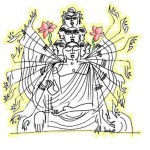Humanist Meditation
I recently spoke, as part of a panel on meditation and Humanism, at the American Humanist Association's annual conference. I will be providing more details on that presentation soon. However, for now I thought I'd share a little of something I'm writing on meditation basics. This explanation will take place over a few parts. Here is the first part for today:
Breathing meditation is the most general kind of attention practice, and necessary in order to perform other kinds of attention practice. It will therefore tend to be the most commonly practiced and introductory of forms. However, foundational though it may be, mastering meditation requires just as much discipline and skill as mastering any other practice, so it would be a mistake to consider it necessarily easier or less advanced than other practices.
While meditators may appear to the outside observer to simply be relaxing, very specific mental exercise is taking place within. A person may seem exactly the same in two sessions but may have had a wonderful success in one session, and performed poorly in another. It is normal for beginning meditators to find meditation trying and difficult. At first, they may even wonder what the big deal is. But over time, noticeable improvement is made, and you will know it in your session as you attain deeper levels. The improvement will also manifest outside your session in the form of greater attention span, depth of attention, focus, and peace of mind. The ability to focus attention and increase awareness is what allows for greater inner and outer mindfulness – and these abilities are foundational to many other practices, as well as the overall endeavor to internalize many philosophic teachings from mere knowledge to a more intuitive level.
Purpose
The basic premise is simple: our untrained minds generally tend to bounce from topic to topic, state to state. This sort of associative jumping about is called ‘monkey mind’ by the Buddhists. It is very noticeable in children, but adults usually suffer from it as well. Even very intelligent people (sometimes especially intelligent people) will tend to ruminate over all kinds of things endlessly. This is seldom a matter of efficient ‘multitasking’. Rather, it is a sort of daydreaming that, at best, results in a lack of focus and being ‘someplace else’ than present. At worst, ruminations can be a source of great frustration and stress. In either case, mindfulness is not possible in such a state because mindfulness involves constant awareness of one’s self, one’s thoughts and feelings, one’s environment, and one’s situation in the present, both internal and external.
Meditation allows us to improve our ability to consciously direct our attention where we decide it will go, and for how long. This is done much like working out a muscle. In meditation, we select something constant upon which to focus. One of the best and oldest things to select is the breath – because no matter your circumstances, your breath is always with you as long as you are alive.
Position
First, it is important to consider your body position. Most people have seen meditators seated with legs crossed, hands either folded in the lap or upturned and resting upon the knees, and a straight posture. These traditional positions may work for many people but we are not so concerned with any one specific position. The key concern, rather, is this: you should sit in a manner that (a) allows you to breathe easily, (b) allows your body enough comfort that you can remain in that position throughout your meditation without your body becoming a distraction, and (c) is not so comfortable that it encourages you to fall asleep.
It is therefore not recommended that you meditate while lying down. Some may choose to sit in a chair, but the chair should allow your posture to be straight enough to breathe well – not slouched. Sitting up straight is one area where initial muscle discomfort will be worth the practice of learning to maintain the posture. As for legs, conditioning over time may enable you to become capable of sitting on the floor with them crossed if that is currently uncomfortable. However, that is a separate physical practice and endeavor - distinct in many ways from the practice of meditation per se. Thus, a seated meditator can become as proficient at meditation as a cross-legged meditator. Again, regardless of the position, the essential matters are that it allows good breathing, is not distracting, and will not make you fall asleep. Essentially, you should use a posture that will allow you to ‘forget about your body’ during the duration of your meditation.
People meditate with eyes open or shut, but shut is generally the preferred. Further, when shutting your eyes, it will be important to learn not to visualize various imagery (something that can be challenging at first for visual thinkers). Instead, the vision should simply be ‘switched off’, even including internal ‘mental visions’.
The mouth can be slightly open with the jaw hanging loose. A good position for the tongue can be let loose, but touching the back of the two front teeth and roof of the mouth, but this may vary for individuals. Again, the key should be relaxation and no distraction.
In the next articles I will continue with notes on body scanning, focusing, going deeper, immediate after effects, and long-term effects.
Meditation Aides
You will also need to think about how long you’re going to meditate. 15 minutes may be a good amount of time for beginners; for some 20 minutes may be ideal. You can eventually work up to 30 minutes. Some meditate longer, but if you want to establish a daily routine it is important to select something reasonable and sustainable within your schedule. You’ll need to establish a way to alert yourself when the time is up. This can be done simply with a stop watch, a kitchen timer, etc. If you are in a guided meditation the guide will alert you. There are also smartphone meditation applications that allow you to set a time and have nice relaxing chime sounds to choose from. There are also online videos available with guided meditations featuring voices, music, etc. However it is achieved, a simple chime after a designated time is probably best for beginners.
Some people light incense when meditating or performing other rituals. The olfactory sense (smell) is one of the most intimately connected senses with our memory centers. Therefore, having a special scent is a good way to shift our state of mind into one that is conducive to the focus of the ritual or practice.
With your surroundings established and your physical position selected, you are now ready to begin.
Body Scan
The first part of the process should be a mental review of your body to ensure you are actually relaxing it. Often we hold muscles tightly clenched without even realizing it. Therefore, you should take a deep long breath and let it out through your nose. Now imagine the top of your head being scanned. As the line around your head moves down over your face, your muscles in that area should relax: first the temples, forehead, brow; next your cheeks, jaw muscles, ears, neck, etc. Move the encircling line down over your neck, shoulders, down your arms to your fingers, down your back, stomach, legs, feet, and toes – relaxing each group as you go. Do not go too quickly so you may consider all areas. If you feel you need to, you can slowly return to the top of your head.
Now take one more deep breath and release your attention from your body. From here after, your breathing should not be controlled – just let yourself breath in and out automatically without trying to direct it, regardless of how fast, slow, deep, shallow, regular, or irregular that is.
Focusing
Now, keeping your eyes closed, focus your attention on your breath. There will be a temptation to control your breath or try to make it regular or deeper, but you should avoid that temptation. Simply watch your breath without directing it. The portion you should zero in on is the air moving just past the edge of your nostrils, as it moves in and out. You will hear it and feel it moving past the nostrils like a tide coming in and out. Try to focus exclusively on that experience without thinking about it in ‘words’. Also ignore any visualizations, sensations from your body, or other thoughts.
At this point, you may find it helpful to count your breaths. If you do so, as you inhale do not think anything – just focus on the inhalation. Then, as you exhale, think, “one...” You can think this word as lasting as long as the exhale, still focusing attention on the air moving out of your nostrils. As you breathe in, try to think nothing in between other than simply observing the inward breath. Breathing out, think, “two…” Go up to five and then return to one. Remember, while you are watching your breaths and counting along, you are not controlling them in any way – simply letting them happen as your body naturally reflexes to breathe.
After you exhale and count a number, if you are rested, there will probably be a few seconds before your body naturally induces the next inhalation. Because you are focused on the inhalation during it’s time, and you are counting during the exhalations, this short period may be the most tempting for your attention to wander. As you complete a counting, such as, “twooooo…”, try to let your mind simply drift off of the end of the word and remain still, thinking of nothing at all until the next inhalation arises to focus upon.
By the way, returning to 1 in the counting in a cycle is important. If you do not return in this cycle from 5 back to 1 and instead continue on to higher numbers, it will be easy for the counting to end up on ‘autopilot’ as your mind wanders off to other things. The return is the indication that you really are paying close attention to the counting. Furthermore, if you fail to remain focused on your breath, you can attempt to simply get through one whole cycle 1-5, thus making the challenge one of bite-sized chunks. Then, you can attempt another cycle – always remaining in the present.
Wandering & Correction
As you attempt meditation, your mind will inevitably wander. Things will pop into your head such as the day’s to-do items, what others around you might be doing or thinking, what the random little sounds you’re hearing might be, physical discomfort, interesting or random memories, or perhaps more concerning ruminations about various life problems. As this happens, it is important to catch yourself and return your focus exclusively to your breath. If you did not, then meditation would not be unlike daydreaming or lucid dreaming. Perhaps a nice endeavor in its own ways, but not meditation. As these things arise in your mind, simply see them as objects and set them aside, moving your focus gently back to the breath.
Despite your best efforts, your mind will do this many times, and will need to be brought back to the breath many times. Just as important as catching and directing yourself back, it is also essential that you not let this frustrate you. Remember, thinking about the fact that you’re not thinking about your breath is also ‘thinking about something other than your breath’. Instead, simply bring your attention back to your breath as though it were a solitary task – without frustration because of past needs to do so, and without aggravation because of a fear of needing to do it again in the future. As you meditate there is only the present, and in that present only the breath. Do not think of this wandering as a ‘failure to meditate’ or as an exception to meditation. The wandering, and the following corrections in focus, are all part of meditation – all is just as it should be.
Next time I will conclude this series on meditation with discussion of going deeper, immediate after effects, and long-term effects.
Going Deeper
Even though a wandering mind and the need to correct its focus back to breathing is to be expected, it is a fact that over time you will become better able to keep your attention on your breath without any other thoughts arising and for longer periods of time between mental wanderings. This increase in ability is noticeable within sessions, but also continues from session to session if you practice meditation regularly.
With that increased ability to maintain attention, comes other effects during the time you are in a meditation session. These include: greater environmental awareness, loss of body, and consciousness detachment.
The first, and easiest to see, is greater environmental awareness. During a meditation you come to notice all of the little and subtle sounds and sensations around you – the clock ticking, birds, cars driving by, the wind, people talking in the distance, and so on. The fact of this awareness as you progress may seem contradictory since these things can be distractions which cause you to have to reset your focus back on your breath. While that is true, it is also true that before you were meditating many of these things would have gone completely unnoticed by you. The reason you notice them during your session is a sign that your mind is becoming still. Throw a pebble into a stormy ocean and its effects are lost, but in a still pond its ripple effects are significant. While the perception of these previously unnoticed things is indeed another set of thoughts to be set aside so focus can be returned to the breath, they are also a sign of progress because a still mind is one of the aims of meditation.
The second effect you may experience during a session may take some practice, perhaps over several sessions, before you start to get glimpses of it. Loss of body is, of course, a figurative description. But the general sensation will be a lack of perception of the body; it’s little aches, itches, tiny movements, etc. This will bring about a feeling of detachment from the body, but is simply the result of an extreme focus. Nevertheless, this feeling – when it happens – is a sign of improvement in your technique.
The tricky thing about loss of body, is that it is not only rare at first, but tends to be very brief. If one is consciously focused on trying to have a loss of body experience, then it is impossible, as the experience results from a lack of conceptual thinking. Once the experience happens, it often ends quickly. Usually, as soon as a person begins to notice that they are experiencing a loss of body sensation, the noticing of it causes the mind to put a label on it, and turn the experience into a mental object. The moment you think, “I’m having a loss of body experience!” you have now lost your focus. Before, you had begun to enter a state of experience without language and labels and without distinctions between things. But calling your mind to think of the loss of body experience creates a distinction between it and other experiences, and between you and your environment. Inevitably, all of the usual concepts flood back into your consciousness. The mind looks to see if the body is there and, of course, it is. Your mind begins ‘checking the mailbox’ to see if any messages (sensations) from the body have arrived – which, of course, they have.
But like everything else, the mind improves over time. With continuous practice, these experiences become more frequent, easier to enter, and last longer.
Another experience you may have during mediation might be called consciousness detachment. We, as persons, are made up of many functions and properties (aggregates) which, working together in complex relationships, yield an overall impression of ‘self’ which we think of as ‘us’. These include memory, emotions, logical ability, selection capabilities, perceptions, and more. But if we were to slowly imagine these properties peeling away, and if we were to look at them individually, there is no one property we could convincingly identify as ‘us’. We are, rather, a function of all of these activities. Another one of these aggregates is consciousness. This is not so much awareness of certain information (such as awareness of our surroundings or of the contents of our thoughts). Rather, this is the actual first-person experience of ‘likeness’ – i.e., what it is ‘like’ to be an experiencing being. One might imagine simpler animals or insects having this feeling of what it is like to be them, without the sophistication of integrated memories of any complexity. Some consciousness philosophers and neurologists call this sensation qualia.
After a person leaves behind all other sensations of body, their surroundings, and other tangible thoughts, their minds enter another state. Here they experience that consciousness in a completely detached form, without the usual accompanying thoughts, feelings, opinions, judgments, memories, labels, sensations, concerns, and other impressions. They simply ‘exist’. Here it is said one can experience the universe ‘as it really is’ bereft of our usual framing of it.
Immediate After Effects
What short-term after effects can one expect from a quality meditation session? The most basic effect is a relaxed and low-stress state, usually accompanied by a sense of patience, contentment, and pleasantness. In addition to these, the mind will be much more focused, controllable, and deliberative. If one were to watch a speaker just after, for example, it would be easier to focus on the speaker for an extended period, while all other distractions would be easily set aside. If one were to engage in some kind of mental task, they would likely be more effective at it, in a heightened state of concentration.
This ‘laser focus’ usually disperses over time. As the day’s activities carry on, the mind has to handle more things simultaneously and attention can become diffused. Certain things have a great tendency to diffuse attention quickly. One of the best examples of this is listening to, or watching, media such as music or television.
Importantly, you have a degree of choice in how quickly or slowly your attention becomes diffused, based on your intent. If you purposely begin filling your mind with a number of ruminations and concerns, you can diffuse your attention more quickly than if you try to remain mindful and in a semi-meditative-like calm after your session.
Longer Term Effects
Longer term effects are usually enhanced when meditation is combined with a solid philosophic foundation. Most of the skills developed in meditation relate to specific philosophic principles and can be used to live these principles more skillfully in life. If meditation were only about the experience during a session, and only about greater focus and stress relief, then it would not have the profound place in spiritual practice that it has had for thousands of years. The general concept of meditation is that, while it may begin as specific sessions, we eventually learn to expand meditative mindfulness into the rest of our lives, thoughts, and actions.
For instance, the first of the deeper effects mentioned earlier, still mind, is something that can be taken into our lives as we live out our day. Beyond that, the ability to notice subtle things that comes from a still mind, can alert us to disruptions and the like arising in our minds before they have the ability to consume us. It may also make us more aware of subtleties in the behavior of others, enhancing our ability to act toward them with empathy.
Having experiences of separation from our bodies and consciousness detachment can create a sensation of oneness with the universe. The ability to enter into such states can create a greater tendency to see things from more of a universal viewpoint than from the viewpoint of our shallow self centered perspective. Some neuroscientists study the physiological effects of meditation on the brain, and these studies have so far lent credence to the notion these changes are more than mere placebo effect. In meditation, we have an integrated practice-philosophy which involves active alteration of our neural architecture, along with mental habits and abilities which facilitate greater application of wisdom teachings, and greater integration of them into our natural responses.
It is in this manner that mindfulness is increased, which can then interject into our normal judgment centers, and better monitor our own thoughts and feelings about things, rather than allow them to consume us mindlessly.









No comments:
Post a Comment